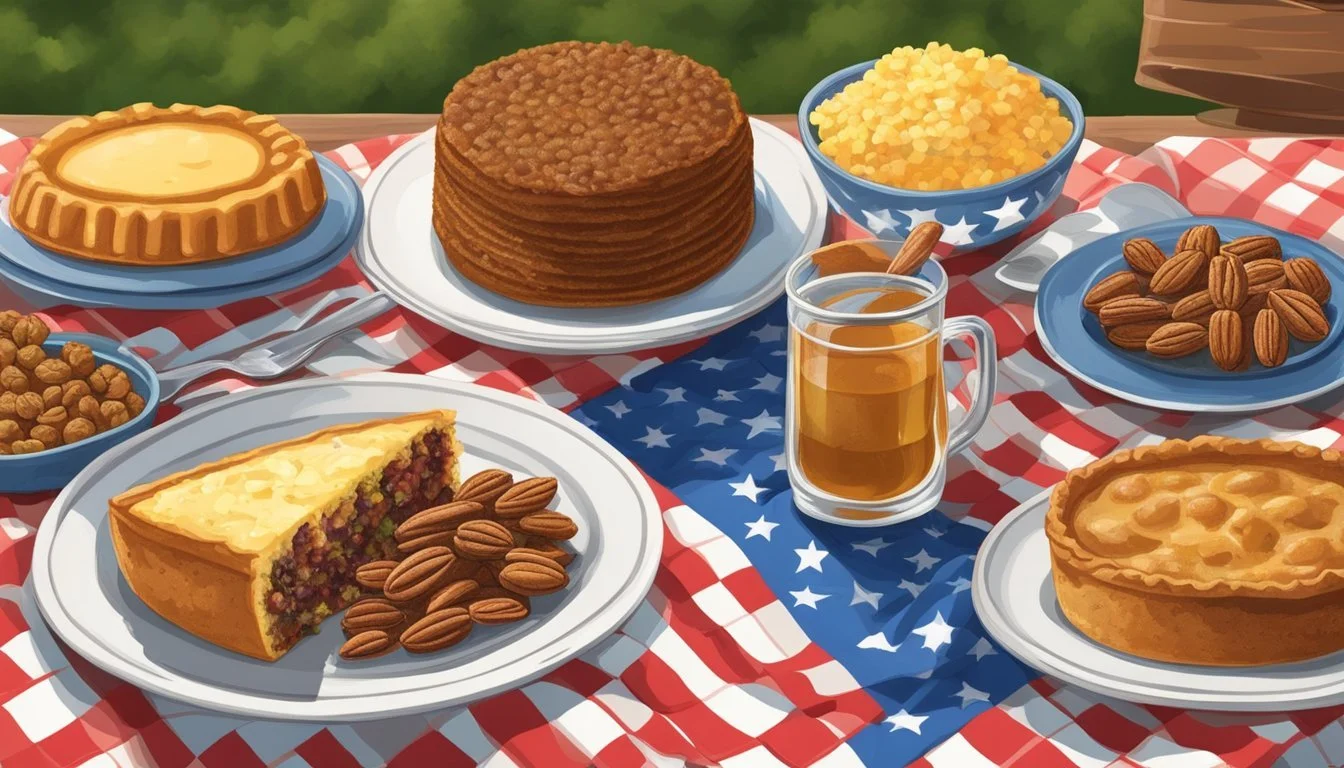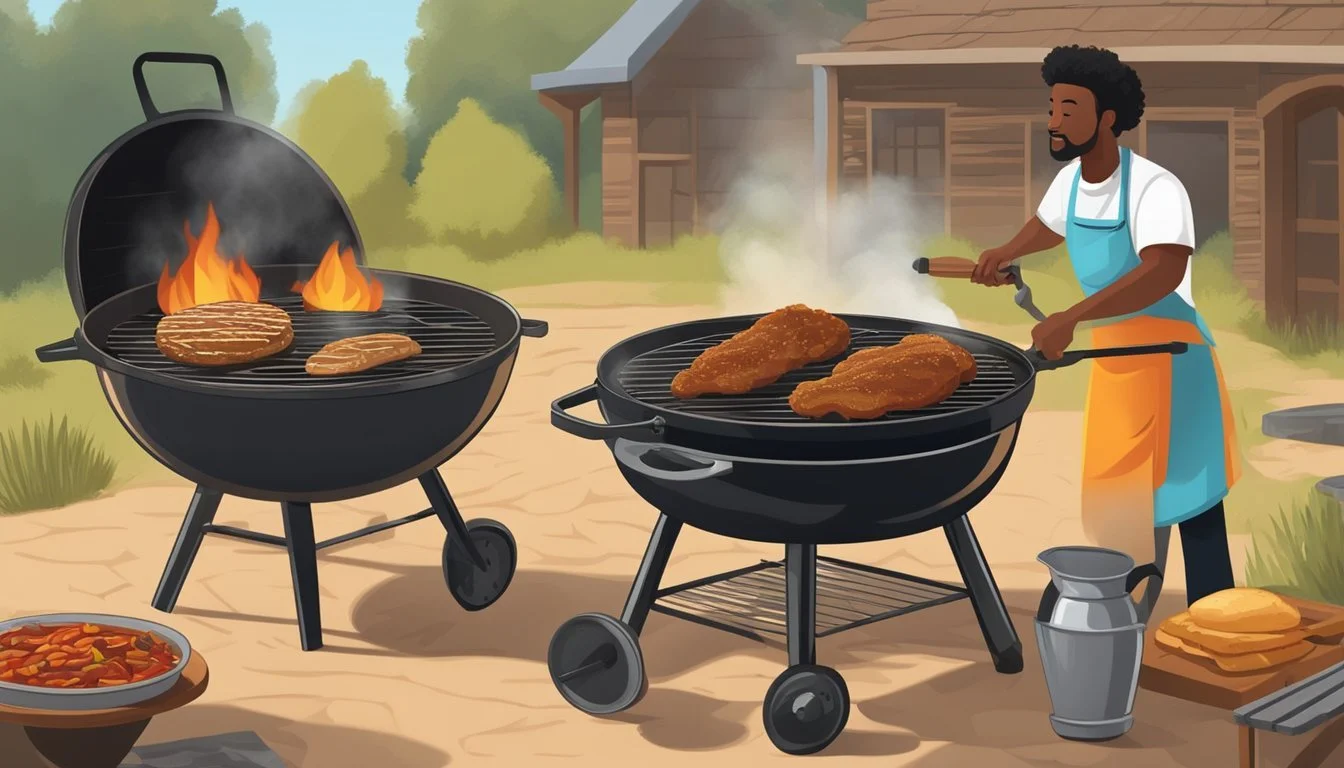5 Texas Food Traditions for Fourth of July
Celebrating with Flavor
As Americans gather to celebrate the Fourth of July, Texans have their unique way of marking the occasion with distinct food traditions that reflect the state's rich culinary heritage. The blend of flavors, steeped in history and local culture, adds a special touch to the holiday festivities.
Why do Texans cherish these culinary customs during the Fourth of July? These time-honored dishes not only bring communities together but also offer a taste of the Lone Star State’s diverse and vibrant gastronomic scene.
1) Smoked Brisket
Smoked brisket is a Texas staple, especially during Fourth of July celebrations. It’s a dish that combines tradition and flavor, often becoming the centerpiece of any patriotic feast.
To prepare smoked brisket, it is essential to start with a quality cut of meat. The brisket should be generously seasoned with a rub that typically includes brown sugar, paprika, garlic powder, onion powder, chili powder, cayenne pepper, salt, and black pepper.
The smoking process is slow and steady. Preheat the smoker or grill to 225°F (107°C) and use wood chips to infuse the meat with a rich, smoky flavor. Patience is key, as brisket requires several hours to reach its tender, juicy perfection.
Throughout the cooking process, maintaining a consistent temperature and occasionally checking the brisket's internal temperature ensures the best results. Aim for an internal temperature of around 195°F (91°C) for that melt-in-your-mouth texture.
Smoked brisket pairs well with classic sides like coleslaw, baked beans, and potato salad. It’s not just a dish but an experience that brings people together, epitomizing the spirit of Texas barbecue.
For those looking for an exquisite smoked brisket in Texas, Franklin Barbecue in Austin is a highly recommended spot. Located at 900 E 11th St, Austin, TX 78702, you can experience one of the best briskets Texas has to offer. Visit their website at franklinbbq.com for more details.
2) Texas-style BBQ Ribs
Texas-style BBQ ribs are a highlight of any Fourth of July celebration in the Lone Star State. Renowned for their smoky flavor and tender meat, these ribs are a must-try. The process starts with preparing the ribs by removing the membrane from the back. This ensures better penetration of flavors.
A dry rub comprising brown sugar, paprika, garlic powder, onion powder, chili powder, cayenne pepper, salt, and black pepper is essential. This mixture is generously applied to the ribs, setting the stage for a flavor-packed bite.
Smoking the ribs at a consistent 225°F (107°C) is crucial. Whether using a charcoal grill or a smoker, indirect cooking is preferred. Wood chips, especially those from oak or hickory, contribute to the signature Texas smoky taste.
Some prefer to baste the ribs with a mixture of honey and other ingredients towards the end of the cooking process. This step adds a sweet glaze and enhances the caramelization.
Grilling the ribs at high heat for a few minutes can also provide a charred texture. The key is to cook until the ribs are tender and the meat nearly falls off the bone.
Authentic Texas BBQ ribs capture the essence of the region's rich barbecue tradition. With patience and the right techniques, this dish can elevate any Fourth of July gathering.
3) Frito Pie
Frito Pie is a beloved Texan comfort food perfect for Fourth of July celebrations. This simple yet satisfying dish consists of layers of Fritos corn chips topped with chili, shredded cheese, and diced onions.
The origins of Frito Pie are a point of pride in Texas culinary history. It's a staple at high school and college football games across the state. The dish is quick to prepare, making it an excellent option for feeding a crowd during holiday festivities.
To make Frito Pie, brown ground beef in a large dutch oven, adding spices like chili powder, cumin, and cayenne for robust flavor. After the meat is cooked, a savory chili base is created.
Once the chili is ready, the next step involves layering it over a bed of crunchy Fritos in a bowl or even directly in a single-serve Fritos bag. Top with shredded cheese, diced onions, and optional garnishes like jalapeño slices or sour cream.
Frito Pie's versatility makes it easy to customize. Some might prefer adding refried beans or a drizzle of hot sauce. Regardless of the variations, this dish remains a fan favorite at Texas gatherings.
Anchoring many a Fourth of July picnic table, Frito Pie embodies the spirit of casual, hearty Texan cuisine.
4) Pecan Pie
Pecan pie holds a special place in Texas food culture, particularly around the Fourth of July. With the state's abundant pecan trees, this dessert is a natural choice for celebrating Independence Day.
Recipes for pecan pie date back to Texas in the early 20th century. The combination of a buttery crust, rich filling, and crunchy pecans creates a dessert that is beloved by many.
Pecan pie recipes vary, but the classic Texas version often includes a mix of corn syrup, sugar, eggs, butter, and vanilla. The pecans are either mixed into the filling or arranged on top for an attractive presentation.
Serving a pecan pie can be as traditional as enjoying it plain or with a scoop of vanilla ice cream. This dessert adds a sweet, satisfying end to any Fourth of July meal.
5) Cornbread
Cornbread is a classic staple in Texas cuisine, especially during Fourth of July celebrations. This Southern favorite embodies the hearty and rustic flavors that Texans love, making it a must-have at any festive gathering.
Traditional Texas cornbread is usually made with simple ingredients like cornmeal, flour, eggs, and buttermilk. The buttermilk adds a tangy flavor while keeping the bread moist and tender.
Some variations include adding cheese or jalapeños for an extra kick. Texans often prepare cornbread in cast iron skillets to achieve a perfectly crispy crust, a signature feature of this dish.
Cornbread pairs well with barbecue and other grilled meats, making it a versatile side that complements many dishes at a Fourth of July cookout. Additionally, it can be served with honey or butter to enhance its rich flavors.
Enjoying cornbread at a Fourth of July celebration creates a sense of tradition and community, encapsulating the spirit of Texas. This beloved bread is more than just food; it's a symbol of comfort and home.
Historical Origins of Texas Fourth of July Food Traditions
Texas Fourth of July food traditions are deeply rooted in the fusion of Indigenous, Mexican, German, and other cultural influences. Understanding these origins provides valuable insights into the rich culinary heritage celebrated on this patriotic holiday.
Influence of Early Settlers and Indigenous Peoples
Early settlers and Indigenous peoples of Texas contributed significantly to the state's culinary traditions. Indigenous communities had a profound impact, utilizing the region's natural resources. They hunted bison and gathered native plants, which became foundational elements of Texas cuisine.
When settlers arrived, they adopted many of these practices. Cooking techniques such as smoking meats over an open flame began with Indigenous practices. Over time, these methods evolved, blending with European techniques. Traditional barbecues, now a staple of the Fourth of July, trace their origins back to this early fusion of culinary styles.
Cultural Melting Pot: Mexican, German, and Other Influences
The diverse cultural landscape of Texas has further enriched its food traditions, especially for the Fourth of July. Mexican influences are evident in the popularity of dishes like fajitas and tacos. These foods reflect the long-standing Mexican heritage within the state.
German settlers introduced practices like sausage making and beer brewing, which have become integral to Texas barbecues and celebrations. Festivals often feature an array of sausages, combining German culinary skills with local tastes.
Other immigrant groups also contributed, each adding unique flavors and techniques. This melting pot of cultures has created a distinctive Texas Fourth of July menu that includes everything from smoked brisket to spicy salsas, showcasing the state's rich and varied heritage.
Signature Ingredients and Their Importance
Texan cuisine shines during the Fourth of July celebrations due to its unique ingredients and flavor combinations. The star ingredients include Texas beef and an array of traditional spices and marinades.
Texas Beef: A Barbecue Staple
Texas beef is synonymous with barbecue. This premium meat is known for its rich, marbled texture and flavors. Beef brisket, ribs, and steaks are central to any Texas-style Fourth of July barbecue.
Careful selection of beef cuts ensures tenderness and flavor. Top choices include brisket, known for its ability to absorb the smoky essence, and ribs, prized for their juicy, tender meat. Cooking methods like smoking and slow-cooking at low temperatures (around 225°F or 107°C) are vital for achieving optimal texture and taste.
Traditional Spices and Marinades
Texan barbecues are incomplete without an assortment of spices and marinades. Key ingredients in these spice blends include paprika, garlic powder, onion powder, and chili powder, all contributing to the signature Texan flavor.
These spices create rubs that enhance the beef's natural taste. Marinades often feature local favorites like Dr Pepper, adding a unique sweetness to the meat. Seasoning the meat at least 24 hours before cooking can significantly enhance the depth of flavor, making each bite a celebration of Texan culinary tradition.
Culinary Techniques Unique to Texas
Texas cuisine during the Fourth of July stands out due to its distinctive slow-cooking and smoking methods and the unique approach to crafting flavorful side dishes. These techniques are deeply rooted in the state’s rich culinary history and cultural influences.
Slow-Cooking and Smoking Methods
Texans are masters of the slow-cooking and smoking process, a crucial technique for making tender, flavorful meats. Barbecue pits and smokers are common, often using hardwoods like oak, hickory, and mesquite to impart a rich, smoky flavor.
The low and slow method involves keeping the temperature around 225°F (107°C), ensuring the meat cooks evenly and absorbs the smoky taste. Dry rubs, combining ingredients like brown sugar, paprika, garlic powder, and chili powder, are applied to enhance flavor before cooking.
The preferred cuts include brisket, ribs, and sausages, which benefit most from long, slow cooking. This method is not just about cooking but also about tradition and patience, aspects that are held in high regard in Texas.
Crafting the Perfect Side Dishes
Side dishes in Texas cuisine are crafted with as much care as the main courses, often incorporating fresh, local ingredients. For example, jalapeño-grilled corn is a favorite, where corn is prepped with butter, lime rind, honey, and salt, then grilled until charred and bursting with flavor.
Corn on the cob is often paired with flavorful combinations like bacon drippings, butter, and fresh garlic, embodying the essence of Texas cooking. Unique blends like sumac butter and fresh herbs add depth to these dishes, making them stand out.
Another staple is pinto beans, slow-cooked with spices and sometimes flavored with smoked meats. These sides complement the smoky, robust flavors of the main dishes, bringing a balance and richness that are quintessentially Texan.










